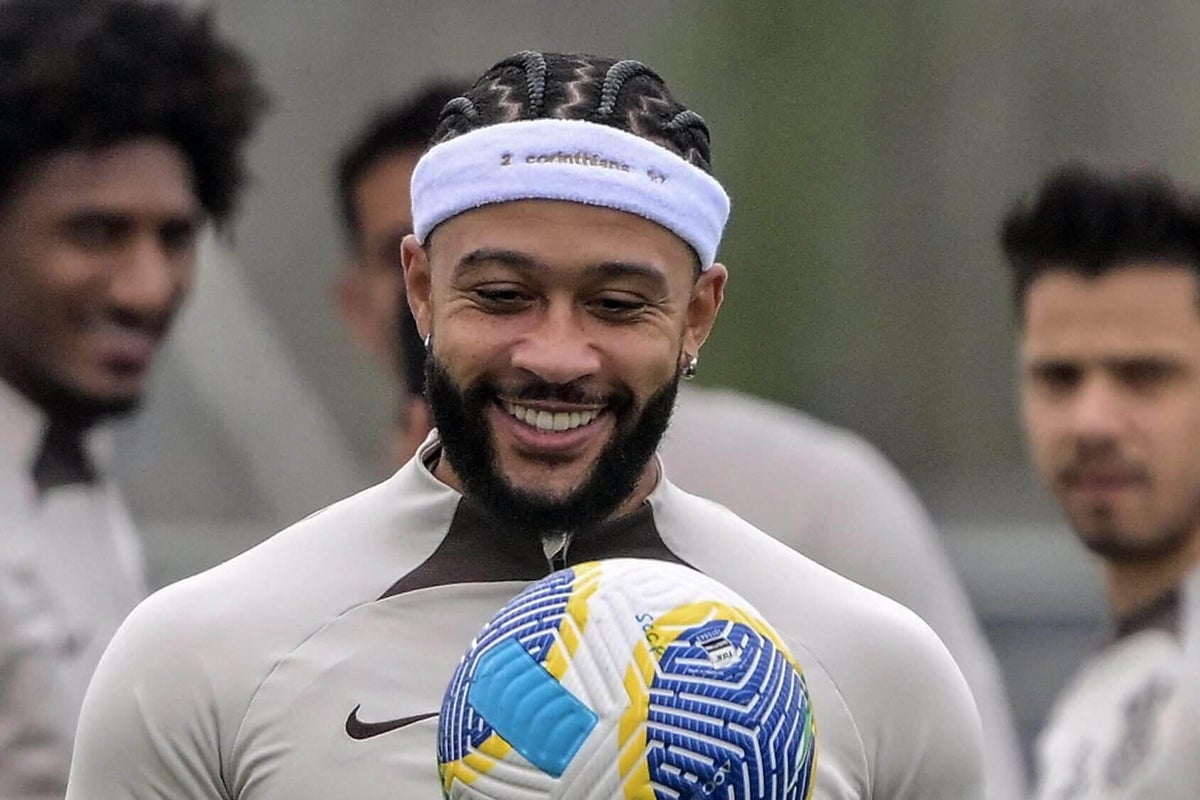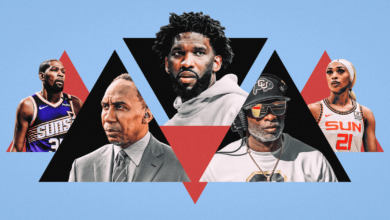Payet, Bolasie and Depay — why are so many random European players going to Brazil?

A recent segment of a sports bulletin on Brazilian television captured the excitement – and bewilderment – created by the influx of European players.
It began with a montage of goals from Memphis Depay, signed by Corinthians last week in a move that has sent large sections of the club’s Sao Paulo fanbase into raptures. Clips of fans imitating the Dutch forward’s trademark fingers-in-ears goal celebration were just a small sample of what we can expect in the coming months.
Then came images of other players: Denmark international Martin Braithwaite; Maxime Dominguez, a Swiss midfielder; 20-year-old Frenchman Mohamed El Arouch; former Norwich City and Newcastle United defender Jamal Lewis.
They have all signed for clubs in Brazil since the end of the 2023-24 European season. The TV segment playfully called the recap a “Tour of Random Gringos”.
That’s not even the full extent of the list, though. The full version of the list would also include former French playmaker Dimitri Payet, who has been with Vasco da Gama since August 2023, and Tobias Figueiredo, once a Portuguese youth player and now on loan from Fortaleza to Criciuma. Spaniard Hector Hernandez is a potential striker for Depay at Corinthians. And then there’s Yannick Bolasie, also at Criciuma. He may have made 50 appearances for DR Congo, but he was born in France and raised in England, making him European enough to be considered an import from what Brazilians call the Old Continent.
A historic move for @Jamal_lewis1 🇧🇷🔥
Congratulations to our client Jamal Lewis who has completed a loan move to the Brazilian giants @SaoPauloFC ✍️ #SPFC #NUFC photo.twitter.com/DakkLuKHb8
— PLG (@PLG_agency) September 3, 2024
It’s a striking trend, whichever way you look at it. Europeans have been to Brazil before – Serbian playmaker Dejan Petkovic is considered a legend at Flamengo and Clarence Seedorf enjoyed a memorable late-career spell at Botafogo – but never have so many been in Brazil at once in the modern era. With numbers likely to rise even further, it seems an appropriate time to ask the obvious question: what on earth is going on?
First, the laws governing the use of players from outside Brazil have been relaxed. Two years ago, clubs were allowed to use a maximum of five foreigners in a matchday squad. That will be reduced to seven in 2023. In March, clubs in the top division of the Campeonato Brasileiro voted unanimously to raise the cap again, to nine.
The impact of those changes is most keenly felt in South America. Brazil has spent years soaking up talent from Argentina, Uruguay and other neighbours; now they can really go wild. Current leaders Botafogo have six non-Brazilian South Americans in their ranks, as do second-placed Palmeiras. Gremio, the traditional home of many such hermanos, has nine. But the extra space has also brought other markets into the equation.
It helps that Brazilian football, in general, has been more sensitive to outside voices over the past decade. Portuguese coaches Jorge Jesus and Abel Ferreira have enjoyed enormous success, following a path that many others have followed. The local football association wanted to break with tradition and appoint Carlo Ancelotti as coach of the men’s national team. Foreign funding has led to modernization behind the scenes. It makes sense that these patterns would be repeated on the pitch.
It’s tempting to see the surge of Europeans as a sign that the Brazilian game is flourishing. From a distance, you might assume that Brazilian clubs have acquired the financial clout to compete for players they previously couldn’t sign, or the kind of international scouting networks that would have been anathema to previous generations. Perhaps recent structural changes – the 2021 law allowing clubs to become publicly traded companies (SAFs), increasing foreign investment, talk of a breakaway league – have lifted the Campeonato Brasileiro up in the world.
That would be an incredibly rosy reading, though. It would be one thing if these signings were concentrated among clubs that had their act together, but there’s no real correlation. Gremio, for example, who signed Braithwaite to replace the departed Luis Suarez in July, are on solid financial footing, but Corinthians are in debt of over two billion reais (£278 million, $368 million). If Depay can’t help them pull themselves out of the relegation zone in the remaining 12 games of the season, they face financial ruin.

Martin Braithwaite played for Gremio last month (Albari Rosa/AFP/Getty Images)
For Rodrigo Capelo, Brazil’s leading expert on football finance, the recent wave of European newcomers is hardly something to be excited about.
“These recent transfers seem more like a fad than anything strategic or based on structural changes in Brazilian football,” he says. The Athletics. “Opportunities have arisen and club owners felt that they would go down well with the fans. Before, they would only sign Brazilians or South Americans. Now they also have the chance to sign European players. They look good in photos.”
The comparison between Seedorf and Depay is interesting. Seedorf was 36 and well past his prime when he joined Botafogo in 2012. Depay is 30 and still a mainstay of the Dutch national team. It would be a step too far to call it a coup, given that none of Europe’s top teams seemed to want him this summer, but it doesn’t feel like nothing.
Depay was keen to portray himself as a kind of ambassador of the future during his first Corinthians press conference. “We always come to bring the Brazilian talents to Europe, because they have something special,” he said. “This league needs a light from the other side. It is time to show its potential. That will happen in the coming years.”
Capelo is not convinced. “It would be positive if this was a real sign that Brazilian football was becoming stronger, more profitable, more responsible and more sustainable,” he says. “If that were true, it would be cool to send that message to the rest of the world by signing players who are still wanted in the European market, but that is not the case.
“None of the players here today could find clubs in Europe. It is interesting that they saw Brazil as an alternative, but it does not change our image on the world stage.”
For Capelo, Seedorf’s example also serves as a cautionary tale. For all the excitement surrounding the signing, for all the inspiration that Seedorf proved on the pitch, the move also symbolized the kind of financial irresponsibility that has so often marked the Brazilian game. When the sponsorship deals and a round of TV bonuses that had funded Seedorf’s arrival dried up, Botafogo found themselves on the brink of collapse. A year after the Dutchman retired, they were relegated to Serie B.

Seedorf playing for Botafogo in 2013 (Ricardo Ramos/Getty Images)
A decade later, much has changed. The rise of SAFs including Botafogo, Cruzeiro, Fortaleza and Bahia is widely credited with bringing in fresh ideas and much-needed investment. The ownership model also tends to shape transfer policy: without presidential elections every few years, there is less temptation for these clubs to go for flashy, big-name signings that would previously have won over fans in the short term.
Botafogo, for example, invested heavily this summer, but only on players whose value could reasonably be expected to increase. “We spent €20 million on Luiz Henrique (from Real Betis), which is not a big deal in Europe but was a record amount in Brazil,” says John Textor, the club’s SAF owner. The Athletics“We then broke it again for Thiago Almada (of Atlanta United). But we think these are investments and we have also invested money in our facilities. When (former Manchester United defender) Alex Telles joined, he told me that our training ground is the best of all the clubs he has ever played for.”
This progress has not been universal, however. Capelo, for example, still sees lingering parallels with the Seedorf era. He points to the recent boom in Brazil’s gambling industry, which has brought money into the game but may not be sustainable. “Certain practices still resemble those of the past,” he says. “A lot of clubs are spending money they don’t have.”
You can understand the appeal to players. Depay is rumoured to earn around £96,000 ($127,000) a week at Corinthians — not a top salary in Europe, but certainly not to be overlooked. He’ll likely be one of the best players in the league. Like Telles, he’s been impressed with the facilities at his new club. “The structure here is similar (to top European clubs), maybe even better in some ways,” Depay said at his unveiling.
There are also intangibles. The lifestyle that wealthy footballers have in Brazil will be very different to that in, say, Saudi Arabia. There is also the allure of playing in what Depay called “the Mecca of football”, plus the undeniable sense of adventure that comes with it.
It’s far less clear whether deals like these bode well for the league. Bolasie is fast becoming a cult hero for Criciuma, but it wouldn’t be a huge surprise if some of the other signings suffered the same fate as Jese and Hugo Mallo, two Spaniards who emerged last year but made minimal impact. And while not all of the European signings represent huge financial gambles, there still seems to be an appetite for the outrageous: UEFA Champions League winners Mario Balotelli and Sergio Ramos have been linked with money-spinning moves in recent months.
As for Depay, his contract includes an escape clause if Corinthians are relegated. The deal was largely financed by one of the club’s sponsors, a betting company.
“These changes are not happening because Brazilian football has become richer,” says Capelo, “but because there is still a lot of irresponsibility.”

(Top photo: Memphis Depay trains in Sao Paulo; by Nelson Almeida/AFP via Getty Images)




